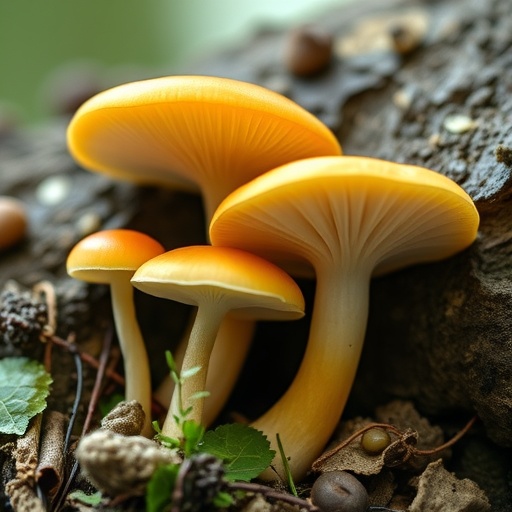In the hushed depths of a Vermont cheese cave, an extraordinary saga of evolution has quietly unfolded—a discovery that not only illuminates the rapid adaptability of fungi but also hints at novel potentials for the future of food science. Researchers led by Benjamin Wolfe, an associate professor of biology, have been closely monitoring the transformation of the mold rind on Bayley Hazen Blue cheese, revealing a remarkable genetic drama that plays out in real time within the dark, cool environment of the cheese caves at Jasper Hill Farm.
This study began rather serendipitously in 2016 when Wolfe, accompanied by his former post-doctoral advisor, visited Jasper Hill Farm under the guise of a romantic proposal but returned with something far more scientifically valuable—samples of a unique cheese coated in a vibrant, leafy green mold. Unbeknownst to them, these samples would catalyze a profound investigation into microbial evolution occurring on the surface of food products. Years later, the stored cheeses revealed an unexpected change: the green mold had shifted to stark white.
Such a striking color transformation in Penicillium solitum fungi is not merely cosmetic but represents a fundamental adaptation. The green mold originally owes its color to melanin, a pigment that offers protection from ultraviolet radiation by acting somewhat like a biological shield. Yet in the perpetually dark caves, this protective pigment becomes superfluous. Graduate student Nicolas Louw observed that the fungi began losing their melanin, an energy-intensive compound to produce, thereby reallocating their resources toward growth and survival more suited to their sheltered cave environment.
At the heart of this shift lies the gene alb1, responsible for melanin biosynthesis. Researchers, including microbiology student Jackson Larlee, unearthed multiple independent mutations disrupting the function of alb1. This was no simple one-off mutation; the white phenotype emerged through an array of genetic alterations, including point mutations that tweak single DNA base pairs and the insertion of mobile genetic elements known as transposons. These “jumping genes” disrupt gene expression by inserting themselves within or near critical genes, effectively silencing them and reshaping the fungal genome dynamically.
The phenomenon observed in the cheese cave exemplifies “relaxed selection,” where organisms lose traits that were once advantageous but are no longer necessary in their current habitat. This type of evolutionary pressure drives diverse life forms—from cave-dwelling fish losing eyesight to fungi shedding melanin—to economize physiologically in the absence of certain environmental stressors like UV light. The Penicillium solitum molds, thus, become a microcosm of broader evolutionary principles at work in real-time.
Fungal adaptation in such controlled yet naturalistic environments opens new frontiers for our understanding of microbial ecology. Since fungi are key players in food spoilage and degradation, insights into their adaptive genetic pathways have direct implications for global food security. About 40% of staple crops are lost worldwide due to fungal rot at various stages of the food supply chain. Learning how fungi modulate their genomes to optimize survival could revolutionize approaches to managing spoilage and mitigating agricultural loss.
Moreover, the research carries relevance beyond agricultural science. Aspergillus fungi—a close relative of Penicillium—pose significant health risks when they colonize human lungs, sometimes causing severe infections in vulnerable individuals. Decoding the molecular underpinnings of how these fungi adapt and persist in specialized niches may eventually inform medical interventions that prevent or counteract such infections.
Intriguingly, the practical side of this evolutionary story also extends into artisanal cheese production. The Wolfe lab, in collaboration with Jasper Hill Farm, experimented with inoculating fresh brie cheese with the evolved white mold variant. After a two-month ripening period, sensory panels reported that this cheese exhibited a distinctive flavor profile—described as nuttier and less pungent compared to traditional blue cheeses. This not only presents new aesthetic and taste possibilities but also suggests that intentional domestication of molds through guided evolutionary processes could redefine cheese-making innovation.
Analytically, the scope of genetic mutations identified in the Penicillium solitum population underscores the dynamic nature of fungal genomes, with transposable elements playing a pivotal role. Historically viewed as genomic parasites, these mobile DNA sequences facilitate rapid genetic diversification that can be advantageous under environmental shifts. Their activity in these cheese caves turns our understanding of genome stability on its head, revealing how genetic “noise” can become evolutionary “signal” in adaptation.
This longitudinal monitoring of microbial communities on cheese rinds certifies that evolution is not a remote, glacial process but an ongoing and observable event, even in the controlled niches humans create. The study bridges microbial ecology, evolutionary genetics, and food science in a compelling narrative that redefines how we perceive molds—not just as spoilage agents but as dynamic organisms with untapped potential for innovation.
The implications of these findings extend to industrial microbiology as well. Utilizing knowledge of fungal gene regulation and mutation pathways could enable the engineering of microbial strains tailored for optimized fermentation characteristics, flavor profiles, or even enhanced safety. This aligns with burgeoning trends in synthetic biology and biotechnological harnessing of microbial diversity to meet societal needs.
In reflecting on this discovery, Wolfe emphasized that witnessing wild molds evolve over a span of a few short years exponentially broadens the horizons for domestication and genetic diversification of fungi used in cheesemaking. By embracing the natural evolutionary processes occurring on cheese rinds, researchers and producers can drive sustainable innovation rooted in evolutionary biology, crafting new varieties with both improved sensory qualities and economic value.
This study, published in Current Biology, exemplifies how precise, long-term monitoring combined with genetic analysis offers unparalleled insights into microbial adaptation. It stands as a testament to the power of integrating basic science with applied research to promote food security, advance medical knowledge, and foster spirited, flavorful experimentation in the gastronomic arts. The humble cheese cave, long regarded as a niche environment, now emerges as a proving ground for evolutionary science in action.
Subject of Research: Not applicable
Article Title: Long-term monitoring of a North American cheese cave reveals mechanisms and consequences of fungal adaptation
News Publication Date: 12-Sep-2025
Web References:
Current Biology article
Image Credits: Benjamin Wolfe
Keywords: Cheese, Evolutionary biology, Transposable elements, Mutational analysis, Fungi, Food microbiology
Tags: Bayley Hazen Blue cheese studycheese cave microbial evolutioncheese rind microbiome analysisfood science innovationsfungal color change significancegenetic transformation in fungiimplications for future food productsJasper Hill Farm discoveriesmelanin in mold protectionPenicillium solitum adaptationreal-time evolution of fungiVermont cheese research






